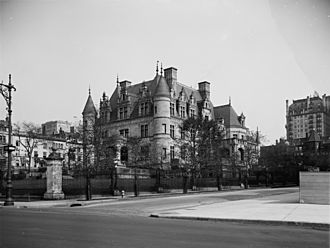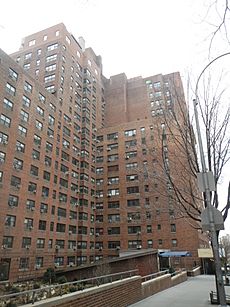Charles M. Schwab House facts for kids
Quick facts for kids Charles M. Schwab House |
|
|---|---|
 |
|
| General information | |
| Architectural style | eclectic Beaux-Arts |
| Location | Manhattan, New York City |
| Construction started | 1902 |
| Completed | 1906 |
| Demolished | 1948 |
| Design and construction | |
| Architect | Maurice Hébert |
The Charles M. Schwab House, also called Riverside, was a huge 75-room mansion in New York City. It was built for a very rich steel boss named Charles M. Schwab. The house was on Riverside Drive in the Upper West Side of Manhattan. Many people thought it was a "white elephant" because it was built on the "wrong" side of Central Park, away from the more popular Upper East Side.
Contents
The Charles M. Schwab House
A Grand Home's Story
The Schwab House was designed by an architect named Maurice Hébert. He created a mix of different styles, mostly Beaux-Arts. The house featured pink granite and was so grand that it made other large homes, like the Vanderbilt mansions, seem small.
Building the Mansion
The design of the Schwab House took ideas from three famous French Renaissance castles: Chenonceau, Blois, and Azay-le-Rideau. It took four years to build, from 1902 to 1906. The cost was a huge six million dollars, which was a massive amount of money back then!
Charles Schwab's former boss, Andrew Carnegie, was also very rich. Carnegie had his own mansion in New York. He once joked about Schwab's house, saying, "Have you seen that place of Charlie's? It makes mine look like a shack." This shows just how impressive Schwab's home was.
Charles Schwab's Life
Charles Schwab was a self-made man, meaning he became successful through his own hard work. He became the president of U.S. Steel and later started his own company, Bethlehem Steel Company. Schwab built "Riverside" after moving from Bethlehem, Pennsylvania to New York.
The land for the mansion was once part of an orphanage. Other large buildings, like the Cathedral of St. John the Divine and Columbia University, were also built in this area. A rich financier named Jacob Schiff had bought the land before Schwab. However, Schiff's wife did not want to live on the "wrong" side of Central Park. This was a sign that the Upper West Side was not as popular as the Upper East Side for very wealthy families.
The House's Final Years
Schwab was known for taking risks in business. Sadly, he lost a lot of his money during the Wall Street Crash of 1929. He passed away in 1939, not as rich as he once was.
Schwab left his mansion, "Riverside," to New York City. He hoped it would become the official home for the mayors of New York. The mayor at the time, Fiorello La Guardia, was known for being practical. He turned down the mansion, supposedly saying, "What, me in that?"
Mayor La Guardia's decision meant the mansion would not be saved. During World War II, a Victory garden was planted on its beautiful grounds. Over time, the area around the house became very crowded. Riverside Drive lost its wealthy feel. By 1947, the huge house was empty. In 1948, it was torn down. A large, red-brick apartment building, now called the "Schwab House," was built in its place.
See also
 In Spanish: Casa Riverside para niños
In Spanish: Casa Riverside para niños


